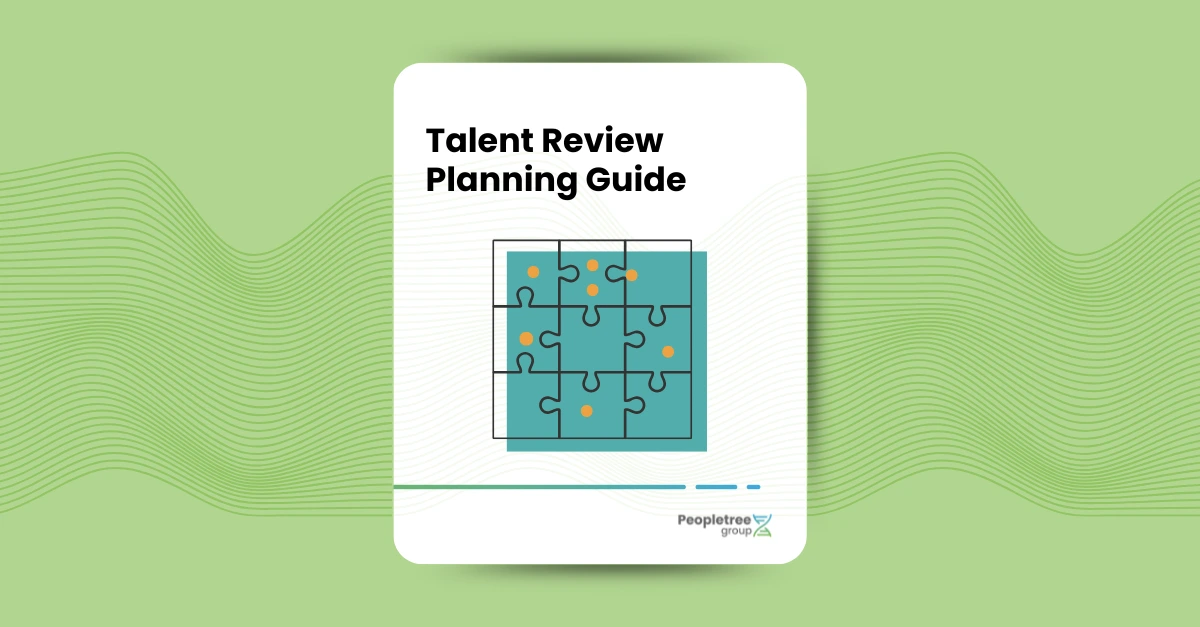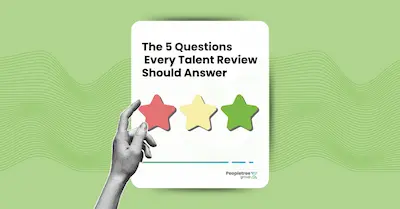JUNE 2025
Most talent reviews don’t tell you what you really need to know. If your process is built around a 9-box or performance ratings alone, you’re probably missing the bigger picture.
A good talent review helps you answer the questions that matter for business growth, and gives leaders the confidence to act.
This article will take you through the five essential questions your next review should answer, and how HR can help drive better decisions.
Q1: Do We Have Enough Talent to Fund Our Growth Strategy?
Just like capital funds your business, talent funds your business strategy. Your review should help you see whether you’ve got enough of the right capability, not just headcount, to deliver on your growth plans. Here’s what your HR team can do to get this right:
Connect strategy to people
Every function in your business is either stable, growing or shrinking, and various things impact this growth context. Ask each team or function if their workload is stable, growing, or shrinking.
For example, let’s say you have 26 High Potentials in your pool of 100 finance people. Is that too many? Too few? Just right? The answer is, it depends.
- In a stable context (little change expected) 26 is too many. Reallocate talent in finance to fund other functions, or they’ll leave for growth.
- In a growth context (e.g. expanding to new markets) 26 sounds right. Enough to fund about a 30% growth in demand.
- In a negative growth context (e.g. gaining efficiency through automation) 26 is way too many. With less opportunity for growth, they’ll disengage or leave.
Spot your growth-enabling roles
Identify which roles directly drive growth (like Sales, Product or Customer Success) and check if you have enough top performers in them.
Know who’s ready to move
Look at how many people are ready to take on more responsibility and how quickly they could step into bigger roles.
Figure out time-to-deploy
For every high performer, understand how quickly you could move them into a new role. Shorter deployment time means more flexibility.
Balance supply and demand
Use growth forecasts to compare business needs with talent availability. Figure out where your gaps are and then plan your hiring or development efforts to close them.
Some roles matter more than others. If a high-impact role isn’t filled by a high-impact person, you’re leaving value on the table, or putting your business at risk. Here’s what your HR team can do:
Q2: Are Our Most Important Positions Filled with High-Impact People?
Your best people need to be in your most important roles. Otherwise, you’re leaving business value on the table. Here’s how your HR team can help:
Map High-Impact Roles
Identify the roles that would cause financial, operational or reputational damage if the role was vacant, or the person in the role under-performed.
Assess performance in context
When assessing performance, look at the context:
- Are they stretched? Build competence in the role.
- Are they performing? Build capacity in the role.
- Are they exceeding? Prepare them for the next level.
Match your best people to your biggest priorities
Match your exceeding performers to high-impact roles first where they’ll have the biggest impact.
Watch for mismatch risk
If someone in a key role is under strain, treat it as a priority. Either give them intensive support, or start planning a transition.
Use role-performance dashboards
Use a simple dashboard to see which important roles are filled by strong performers, and where you might have gaps.
Q3: Are We Developing the Right People in the Right Way?
Development shouldn’t be one-size-fits-all. Some people need depth. Others need stretch. Your review should help tailor development to both performance and potential. What your HR team can do:
Time it right
Use current performance to decide when to develop someone. Focus on building confidence, mastery, or readiness depending on where they are now.
- Stretched → Build basic competence
- Performing → Develop mastery
- Exceeding → Prepare for advancement
Tailor the approach
Use potential to determine how to develop someone.
- High Professionals → These individuals need to deepen their mastery (technical or functional).
- High Potentials → These individuals need to broaden their experience (cross-functional or leadership).
Be clear on destination
Don’t train for the sake of it. Know where each person is headed, and develop them toward a realistic future role. Ask: “Where do we want this person to go, and what do they need to get there?”
Be clear on readiness
Don’t promote someone on potential alone. High potentials must how they have the capability and the track record for the job.
Plan moves for high potentials that expose them to different areas of the business. Identify two functions they could rotate into and what value they’d bring.
4: Are We Managing Retention Risk in Critical Roles?
High Impact People (HIP) will leave. The question is when, and whether you’re prepared for it.
Define High Impact People
Define High Impact People as those who are in critical roles who are also top performers. Focus your retention strategy here first.
Run a risk check
Look at internal push and pull factors, and external push and pull factos:
- Is the industry becoming less attractive?
For example: fewer opportunities, tighter margins, declining reputation. Are competitors offering better pay, roles, or benefits?
This is what could tempt them away.Are they feeling unhappy or undervalued here?
This might cause them to slowly check out.Are we overlooking their needs or growth goals?
Sometimes we lose good people without realising we’ve created a gap.
Track risk levels
Score and monitor flight risk based on manager input, employee feedback and previous turnover patterns.
Have a back-up plan
For any HIP at moderate or high risk of leaving, know who could step in and how long it would take to backfill.
Engage early
Don’t wait for the resignation letter. Use retention conversations, not exit interviews, to talk about growth goals, frustrations and career fit.
5: Do We Have the People Leadership We Need to Support Growth?
As the business grows, you’ll need more leaders, not just more people. But leaders take time to develop. And not every great specialist is a great people leader.
Label your leaders
Tag every manager as either a People Leader (managing people) or a Process Leader (managing work).
Check your leadership pipeline
Filter your 9-box to isolate high potentials who are People Leaders. Do you have enough high potentials who are ready for broader or more complex people management roles?
Spot who’s promotable
If someone is a strong process leader, but tagged for succession, check if they’ve had any real people management experience. If not, design that exposure in now.
Start development early
Introduce stretch projects, team leadership roles and mentoring to help specialists practice leadership before they’re promoted.
Align succession to org design
If your business is moving toward functional scale, you’ll need more “leaders of leaders.” Build this into your review process.
Our talent review solution helped this client save 10, 000 hours per annum
- Eliminate Excel-based processes with a self-directed employee assessment and development tool
- Provides 360-degree feedback, performance management and personalised development plans
- Accurately identify the right talent for every role.









